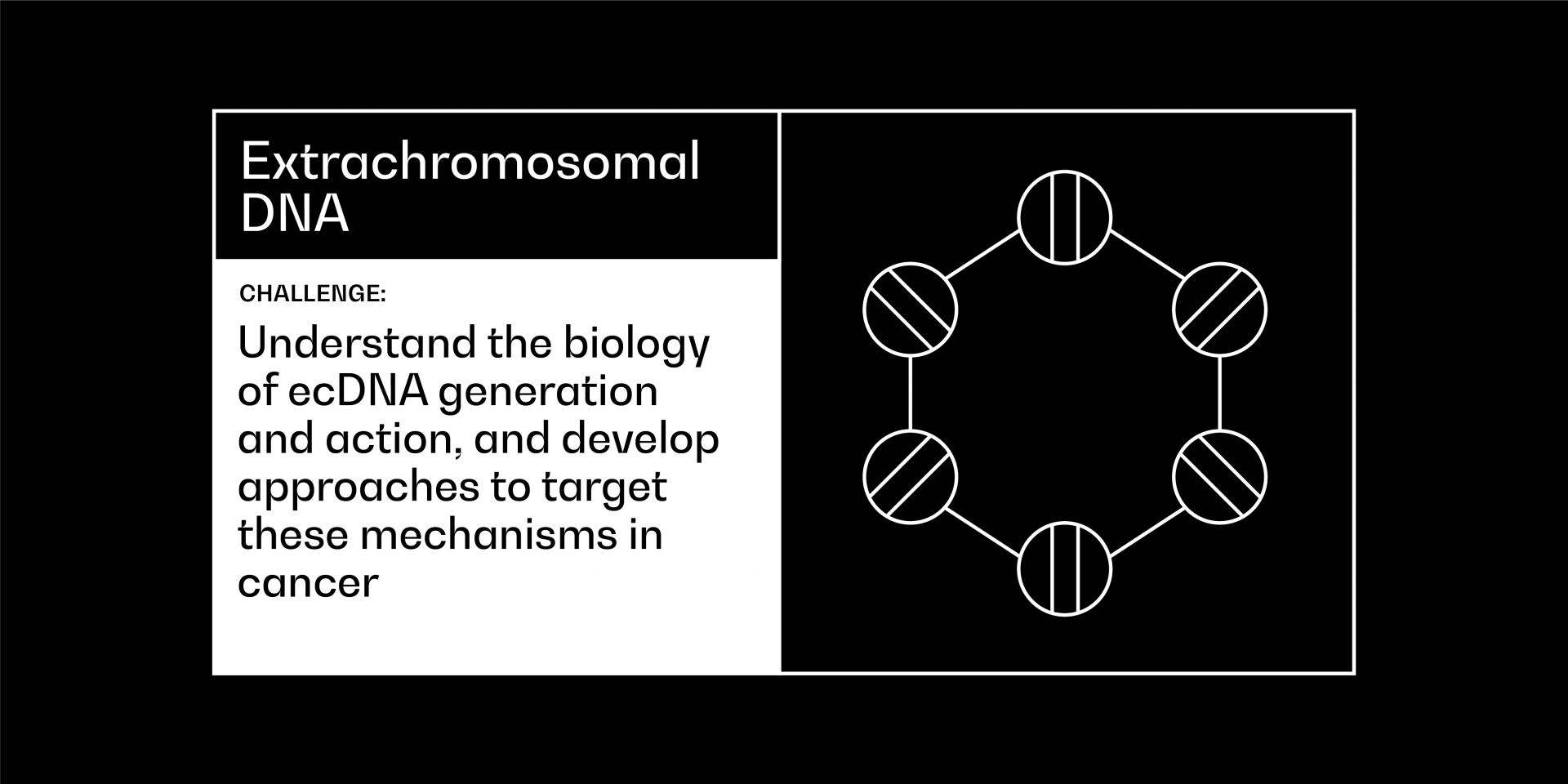
Extrachromosomal DNA
Cancer Grand Challenges is series of £20m ($25m) awards that give international teams of researchers the freedom to think differently, act creatively and explore truly innovative science to take on fundamental questions in cancer.
Context
Extrachromosomal DNA (ecDNA) is increasingly recognised as a potent source of driver oncogene copy number amplification events in human tumours. ecDNAs have been found to be associated with hijacked enhancer elements, driving the expression of multiple oncogenes simultaneously and are likely sources of tumour heterogeneity, drug resistance and cell fitness. Reintegration of ecDNA intrachromosomally, within homogeneously staining regions and unequal distribution of ecDNAs at cell division to daughter cells presents challenges to their detection and control.
Relatively little is known about the origins, evolution, genomic organisation or clinical impact of ecDNA. Tools now exist to infer their sequence, structure and regulation that when combined with advances in ecDNA biology in prokaryotes and lower eukaryotic cells, would allow a greater understanding of therapeutic vulnerabilities in intractable cancers.
Barriers and opportunities
Little is known about the genomic organisation or mechanisms that drive ecDNA formation or reintegration in cancer that could be targetable. However, research over the last 50 years in both eukaryotes and prokaryotes has revealed the role of ecDNA in immune evasion (bacteria) and in ageing, chromosome evolution and genome instability.
Current short read sequencing platforms render the detection and inference of ecDNA challenging. Therefore, optimising ecDNA purification and enrichment approaches, sequencing technologies and informatics tools will be important. The absence of centromeres results in unpredictable segregation of ecDNA at mitosis, challenging our evolutionary thinking in cancer. The impact of such non-mendelian patterns of inheritance have not been modelled or studied in depth in cancer.
Driver “undruggable” oncogenic events such as N-Myc are subject to ecDNA driven amplifications and drug resistance enzymes may be transiently fuelled by such events. Understanding ecDNA evolution and their conserved patterns of organisation could inform wider knowledge of genome organisation, enhancer activity and the role of epigenetic regulators in controlling genome stability. For example, histone methyltransferases implicated in their generation, are now eminently targetable.
Examples of the types of questions that could be addressed in this challenge include but are not limited to:
- What is the biological mechanism(s) involved in the generation of ecDNA?
- What is the role of ecDNA in oncogenesis?
- Are there targetable vulnerabilities to ecDNA-driven cancers that could be exploited for treatment?
- Can we model and predict ecDNA evolution?
- Are there therapeutic targets that would eliminate ecDNA? Stop its integration into chromosomal DNA? Or block its re-emergence from genomic integration?
Vision and Impact
This challenge should synthesise our understanding of conserved patterns of ecDNA genomic organisation and drive discoveries into their regulation, evolution and re-integration. This could provide new therapeutic targets to maintain genome stability in cancer.
A multidisciplinary team will be required to address this challenge, which could coalesce the fields of cellular and evolutionary biology, cancer genomics, drug discovery and development, and computational modelling to understand how ecDNA structures form and how they could be limited.
Knowledge gained from this challenge could provide tractable therapeutic approaches to undruggable oncogenes (e.g. MYC), limit the over-expression of multiple oncogenes simultaneously and prevent the rapid acquisition of drug resistance through metabolic enzyme overexpression.
Plain language summary: Why extrachromosomal DNA?
Our DNA is mainly coiled into structures called chromosomes, which keep its long strands neatly organised. But cells can also contain small rings of DNA that exist separately from these chromosomes, called extrachromosomal DNA (ecDNA).
New research has revealed that cancer cells contain vast numbers of ecDNA loops, often containing many copies of genes that help the cancer grow and survive. These rogue pieces of DNA can also change and multiply rapidly and are believed to help the cancer to adapt, evolve and become resistant to treatment. But the exact role of ecDNA in cancer is unclear.
If we can understand how ecDNA forms and changes in cancer, we could create new therapies that target it. This Cancer Grand Challenge invites researchers to harness the latest genetic technologies and draw on new knowledge gained from studying ecDNA in microorganisms to make this possible.